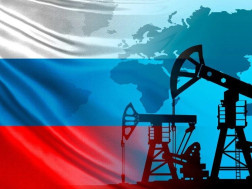Russia's seaborne crude oil exports dropped 9% in the first month of the European Union's embargo and price cap, falling well below 3 million barrels a day to their lowest level in 15 months, according to Kpler data compiled by Anadolu.
The EU banned imports of seaborne crude oil from Russia and insurance and financing of the transport of Russian oil to third countries, particularly through maritime routes. The EU's prohibition came into effect on Dec. 5.
The EU, the G-7 group of industrialized nations, and Australia agreed on a price cap for Russian oil at $60 per barrel that came into effect the same day.
In response to the price cap, on Dec. 27 Russian President Vladimir Putin signed a decree banning crude oil and oil products supply to nations that apply the cap, starting from Feb. 1 for five months.
From 3.05 million barrels per day in November, Russia's seaborne crude exports fell to 2.79 million barrels per day in December, down 266,000 barrels a day in the first month of the EU's oil embargo and price cap,
Despite the drop in the country’s overall seaborne crude exports, India was the top importer of Russian crude in December with 1.3 million barrels a day.
China's seaborne crude imports from Russia remained steady at 950,000 barrels a day in the same period.
Together, the countries accounted for 82% of Russia's daily seaborne crude exports last month.
"Russia is sending more crude oil produced in the Arctic region, Varandey and ARCO crude grades, to China and India after losing out on the usual discharge locations in Western Europe," Neil Crosby, senior analyst at London-based data provider OilX, told Anadolu.
Russian crude rising in new Asian destinations
In addition to India and China, Russian crude oil exports to other nations in Asia, such as South Korea and Japan, are picking up, data shows.
In the first month of the price cap, South Korea imported 44,725 barrels of seaborne crude oil a day from Russia, almost doubling its November imports of 23,500 barrels a day.
Japan, which has had zero crude imports from Russia since June 2022, imported 22,600 barrels a day in December.
But Italy, one of the largest buyers of Russian seaborne crude oil in Europe, cut its imports 71% to 34,000 barrels a day in December compared to the previous month.
The Netherlands, another top buyer of Russian seaborne crude in Europe, had zero seaborne crude imports from Russia last month.
In November, the country's seaborne crude imports had stood at 102,835 barrels a day.
As Bulgaria is not taking part in the sanctions, flows are historically elevated, according to Kpler.
Bulgaria imported 160,000 barrels of Russian seaborne crude a day, while Türkiye's imports fell 56% to 76,500 barrels a day during the same period.
Russia's exports via Druzhba also falling
According to OilX, despite the sanctions on Russia, the country's crude oil exports did hold up very well until December.
"But then we noticed a drop in exports by some 400,000 a day," Neil Crosby, OilX senior analyst, told Anadolu.
"As we move into first quarter of 2023, we expect a further drop on the northern Druzhba leg towards Poland and Germany."
The Druzhba pipeline, also known as the Friendship Pipeline, is the main line carrying oil from eastern European Russia to Ukraine, Belarus, Poland, Hungary, Slovakia, the Czech Republic, Austria, and Germany.
Germany and Poland committed to halt oil imports through the pipeline starting on Jan. 1.
According to new research by the Centre for Research on Energy and Clean Air (CREA), the EU's ban on crude oil imports from Russia and oil price cap is set to cost Russia €160 million ($171.7 million) a day.
As the EU ban on refined oil imports and the extension of the price cap to refined oil products comes into effect by Feb. 5, Russia is estimated to lose a further €120 million a day, AA reports.
















